
* The Guadalcanal campaign began with green American sailors and Marines taking the fight to an aggressive enemy that had given the US a succession of thorough and humiliating beatings through much of the previous year. The landings on Guadalcanal took the Japanese off guard, but they responded with naval force and inflicted a stinging defeat on the Allied invasion fleet. However, the Americans had effectively taken possession of Guadalcanal, leaving the Japanese in what would prove to be a most difficult position of dislodging them.
* On 5 July 1942, reconnaissance overflights of Guadalcanal revealed the IJN was building an airfield on Guadalcanal, a Japanese convoy having arrived there the week before to begin construction. If they completed it, Japanese aircraft would be able to control the sea lanes in the region, rendering Allied sea movements difficult. As an immediate response, Army and Seabee teams scouted out islands in the northern New Hebrides for an air base, more forward to the Solomons than Efate in the south. The island of Espiritu Santo was selected for the base, which was quickly set up and put into operation, with bombers flying from there to raid Guadalcanal by late July. Espiritu Santo would become a major forward base for operations in the Solomons.
In the meantime, resources were scraped up for the assault on Tulagi and Guadalcanal, codenamed Operation WATCHTOWER, under the overall command of Vice Admiral Robert L. Ghormley, operating from Noumea. Ghormley assigned tactical control of the operation to Vice Admiral Frank Jack Fletcher, who had fought at the Battles of the Coral Sea and Midway. The main assault force was to be the 1st Marine Division, then assembling in Wellington, New Zealand, under the command of Major General Alexander Archer "Archie" Vandegrift. The Amphibious Force that would carry and land the Marines was under the command of Rear Admiral Richmond Kelly Turner.
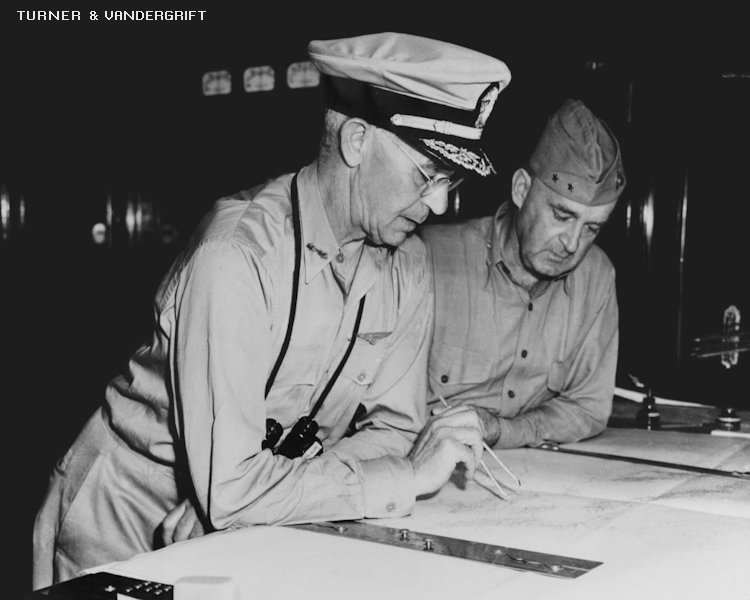
WATCHTOWER would be the first major American amphibious combat operation since 1898. The 1st Marine Division had been scheduled for six months' training before going into combat, but now they were to be in action in about a month, in early August. Preparations proved nightmarish. It was effectively winter in the Southern Hemisphere, the weather was cool and relentlessly rainy, and sick lists were long. Supplies were arriving by sea, but the shipments had not been well organized or planned, the result being a confused mess on the docks. Vandegrift put his troops to work in shifts, unloading and sorting the material on the waterfront, and gave orders to focus only on the absolute necessities of fuel, ammunition, and supplies needed for combat operations.
There wasn't enough of it all for comfort. On 24 July, the US chiefs of staff agreed, under British urging, to invade French North Africa before the end of 1942. TORCH, as the operation was codenamed, had priority over the assault on Guadalcanal, and the poverty of resources for WATCHTOWER did nothing to encourage doubters. Intelligence on Guadalcanal was sketchy as well; Australians familiar with the place couldn't provide much more useful information than that it was a "bloody stinking hole", and no detail maps of the island were available. A Boeing B-17 Flying Fortress was dispatched to survey the island for a photo map, and that would have to do. The Marines nicknamed the effort Operation SHOESTRING.
On 26 July, Vandegrift and Turner met with Fletcher at sea on board Fletcher's flagship, the carrier SARATOGA. Fletcher had little faith in the operation, being more concerned about protecting his carriers: there were only four US carriers in the Pacific, and three were committed to WATCHTOWER. Fletcher bluntly told Vandegrift and Turner that the carriers would only remain in the combat area for 48 hours after the first landing. Normal amphibious warfare doctrine was to keep the fleet around until the landing force was established -- and absolutely no longer, since during that time it was a sitting duck for air and naval attacks. Fletcher was cutting it much too thin for Vandegrift's and Turner's liking; but they were not being asked, they were being told, and there was nothing they could do about it.
A practice landing took place on the island of Koro in the Fijis from 28 July. It was, as Vandegrift put it later, "a complete bust", with absolutely nothing going right. He was appalled at the thought of what would have happened to the confused mass of sailors and Marines had they been trying to land on beaches defended by an aggressive enemy. There was no time for a second practice, and all Vandegrift could do was rest his hopes on the old saying that "a poor rehearsal means a good performance."
* The Japanese remained almost entirely ignorant of these preparations. Many of the Japanese military command were suffering from "senshou byouki (victory disease)". They had easily won almost every battle they had fought so far in the conflict, and they generally believed they would win just as easily in the future. The stinging defeat at Midway had not been made public and did not deeply disturb this belief. Few senior military officers believed there would be a serious Allied counterstroke against Japan until well into 1943.
There were those among them who were more realistic in their thinking, including Lieutenant Commander Itou Haruki of the Naval Intelligence Center in Tokyo. In late July, his unit identified two new Allied radio callsigns, both operating on the 4.205 megahertz band and communicating with Pearl Harbor. On 1 August, Japanese radio direction finders pinpointed the location of the stations as Melbourne and Noumea. Itou correctly guessed these were headquarters for Allied operational forces, massing for an attack on New Guinea or the Solomons. He relayed an urgent warning to Truk, the main Japanese base in the central Pacific, and Rabaul. The warning was disregarded, there being nothing much there to sort it out from the usual noise of intelligence reports.
BACK_TO_TOP* Before the end of July, US Navy Task Force 61 was under way, with 82 vessels carrying or protecting the 19,000 men of the 1st Marine Division. The Tulagi landing force was carried on four transports and four "Auxiliary Personnel Destroyers (APD)" -- old destroyers that, from 1939, had been partially stripped of armament and kitted up to act as assault transports, with small load capability but high speed compared to a conventional transport vessel. The APDs would play a prominent role in the subsequent campaign.
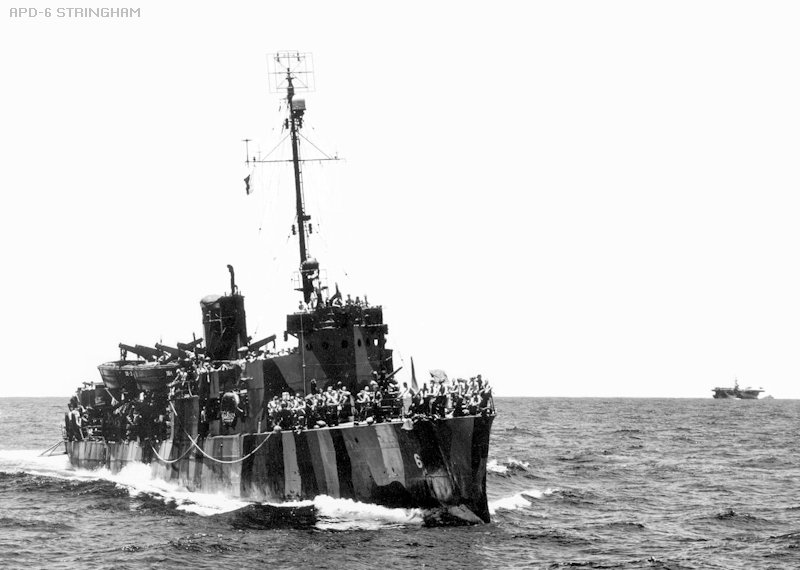
The Guadalcanal landing force was carried on a total of 15 transports and cargo vessels. The transports were escorted by eight cruisers, three of them Australian, and a destroyer screen. The carrier force remained about 160 kilometers (100 miles) to the south; it consisted of three carriers, one battleship, five heavy cruisers, sixteen destroyers, and three oilers.
After sundown on Thursday, 6 August, the Marines began their preparations for landing. The carrier force moved to waters south of Guadalcanal, while the assault force steamed around the western end of the island.
Guadalcanal has a roughly oval shape, twisted north at the western end and south at the eastern end. The northwest tip is Cape Esperance, with the north coast running southeast until it reaches Tassafaronga Point, where it turns flat east until it reaches Taivu Point, then turns southeast again. The island's terrain is very rugged, with a spine of mountains running down the center and extending their reaches to the southern shore. The northern shore has level areas and hills, and is the only area practical for major military operations.
The airfield that the Japanese were building on the island was about halfway between Tassafaronga Point and Taivu Point, behind a place called Lunga Point. The airfield was flanked by the Ilu River to the east and the Matanikau River to the west. Well to the south of the airfield was a rugged peak named Mount Austen.
Directly north of Cape Esperance, about 15 kilometers (10 miles) offshore, is Savo Island, an oval a few kilometers wide. Florida Island is about 32 kilometers (20 miles) away, farther east, and is about 32 kilometers (20 miles) long. Its fine natural harbor faces Guadalcanal, protected from the sea by little Tulagi and a few other islets, including Tanambogo and Gavutu.
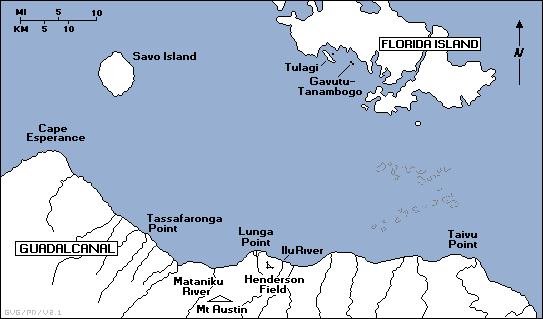
* When the sun came up on Friday, 7 August 1942, the Japanese on the islands were confronted by a huge fleet that had appeared out of nowhere; despite Guadalcanal's forward position, the Japanese hadn't set up effective air or sea patrols. US Army Air Force B-17 bombers flying out of Espiritu Santo had been hitting Tulagi and Guadalcanal for the previous week, but the Japanese had not seen anything ominous in the increased level of air attack. A Japanese radio operator on Tulagi keyed off a message to Rabaul:
LARGE FORCE OF SHIPS, UNKNOWN NUMBER OR TYPES, ENTERING THE SOUND. WHAT CAN THEY BE?
He found out soon enough, with US Navy Grumman F4F Wildcat fighters arriving to shoot up Japanese seaplanes in Tulagi harbor, and do whatever other damage they could; US Navy destroyers then moved in and started to pound Japanese positions on Tulagi. The radio operator concluded with a final message, the shelling then silencing the radio:
ENEMY FORCES OVERWHELMING. WE WILL DEFEND OUR POSTS TO THE DEATH, PRAYING FOR ETERNAL VICTORY.
They were as good as their word. For 31 hours the Japanese on Tulagi -- all IJN Special Naval Landing Force troops, more of a shore facilities guard organization than an amphibious force like the USMC -- held out against the Marines, charging the Americans theatrically and suicidally over the old cricket field, and more effectively firing on them from caves until the Marines silenced them with explosive charges. In later campaigns, the Americans would rely more heavily on flame throwers to take out Japanese fortified positions.
The Japanese put up a similarly stubborn fight on Gavutu and Tanambogo, assisted by the fact that the two little islands were surrounded by coral reefs, and the only places to land were unpleasantly exposed to fire. The Marines lost 144 men killed and 194 wounded. There were about 800 Japanese on the three little islands, with about 700 of them killed, 23 captured, and only three of those voluntarily surrendering. The survivors swam to Florida Island; cleaning them out would take several weeks.
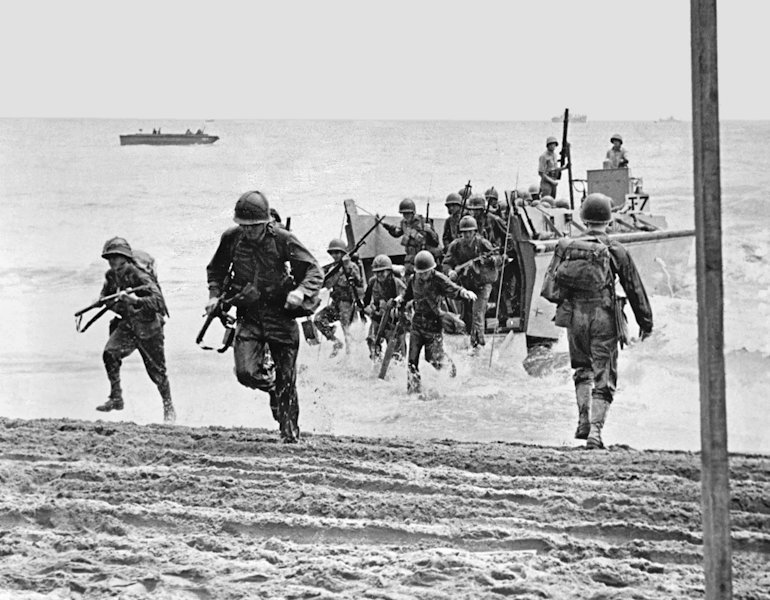
The landing on Guadalcanal itself on Friday was unopposed, and there were no Marine casualties. The Japanese on the island were mostly poorly-armed construction personnel -- many of them actually conscripted Korean laborers whose motivation was limited -- and took off into the jungle in surprise. The only real problem for the Americans on Guadalcanal was the pileup of supplies on the beach, there being no effective way to move them inland, and not enough labor available to handle it all. Combat commanders didn't want their troops to help out, since there was no way of knowing if the Japanese were preparing a counterattack; if the Marines were focused on handling cargo, they might be caught dangerously flat-footed.
Unfortunately, the pileup on the beach created a bottleneck that prevented the speedy offload of the cargo ships of the invasion fleet, and that would lead to a big problem very quickly. However, the unarmored tracked amphibious tractors -- "amtracs" -- used to haul supplies to the beach proved very useful. There was only a handful of them, but the utility of the amtracs suggested they would be a real asset in future Pacific amphibious operations.
* Two hours after the first landing, the invasion fleet received a message from Paul Mason, an Australian coastwatcher on Bougainville, that 24 Japanese torpedo bombers were headed their way. Actually, the raiding force consisted of 27 Mitsubishi G4M twin-engine bombers and seven Aichi D3A1 dive bombers, plus an escort consisting of Mitsubishi Zero fighters. They had been preparing for a raid on New Guinea from Rabaul, but had been hastily reassigned to attack the American fleet instead, even though Guadalcanal was 1,050 kilometers (650 miles) away, and they were certain to run out of fuel. The Japanese aircraft were loaded with bombs and not torpedoes, making attacks on ships difficult -- but they did what they could against the maneuvers of Allied vessels, anti-aircraft fire, and Grumman Wildcat carrier-based fighters.
A second wave of Japanese bombers followed two hours later; they created great confusion, but did little real damage. Air battles would continue through the next day, with the Japanese losing 42 aircraft -- many of them simply running out of fuel, the long range of the missions proving a severe handicap to the Japanese -- but sank the transport GEORGE E. ELLIOT and damaged the destroyer JARVIS. The transport was lost after a damaged G4M deliberately flew into it. The JARVIS limped south for repair, to then simply disappear; it wasn't learned until after the war from Japanese records that it had been sunk by Japanese torpedo bombers, leaving no survivors.
Although the Wildcat was generally perceived as inferior to the Zero, being slower and less agile than the Japanese fighter, it was far sturdier and could at least escape a Zero in a dive. The American pilots were also well trained, pilot skill being the most significant single factor in air combat; while the Japanese had skilled pilots of their own, they still perceived themselves at a disadvantage to the American defenders. The Americans would maintain air superiority over Guadalcanal, if sometimes by the hardest.
* The Marines suffered no casualties on Guadalcanal all through D-Day, and by the evening of 7 August there were 11,000 of them ashore. During the night, the inexperienced Marines were easily spooked by strange jungle sounds and prone to fire into the bush at nothing in particular -- though sometimes the target turned out to be only too specific, at least one Marine being killed by his own. The next day, Saturday 8 August, Saturday 8 August, they moved inland against the airfield and captured it with little resistance.
The invasion was just in time: the airfield was almost complete, and if it had been operational it would have made the assault far more problematic, as subsequent events would demonstrate to the Japanese. The Japanese had been too surprised to destroy their equipment and supplies before they were evicted, so the Marines also obtained trucks and construction equipment; fuel, construction materials, and large stocks of food; and even an ice-making machine. The Marines put up a sign:
TOJO ICE CO -- Under New Management
The Marines had taken Guadalcanal easily. Keeping it was not going to be as easy.
BACK_TO_TOP* When the news of the invasion of Guadalcanal reached Rabaul on 7 August, Lieutenant General Hyakutake Harukichi, commander of the Imperial Japanese Army's (IJA) 17th Army there, believed that the main Allied counterstroke would fall on New Guinea and that the Guadalcanal operation was merely a diversion. Guadalcanal was an IJN matter anyway, the IJA having little or no knowledge of what the IJN had been doing there, and was of no real concern of the IJA.
Vice Admiral Mikawa Gunichi of the IJN found Hyakutake's attitude dangerously complacent, Mikawa correctly recognizing the landing as a serious offensive operation. The interservice rivalries between the IJA and IJN were so bad that they made the fractious relations between the US military services look cozy in comparison, and Mikawa made little or no attempt to argue the matter with the IJA. Instead, Mikawa threw together a scratch force of sailors and sent them immediately to Guadalcanal in a cargo ship, the MEIYO MARU.
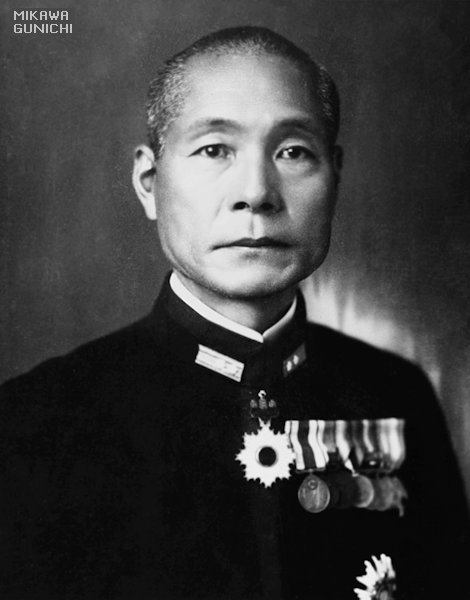
Mikawa went further, asking the IJN General Staff in Tokyo for permission to launch a surface attack on the Allied fleet. IJN Chief of Staff Admiral Nagano Osamu did not like the idea, believing that Mikawa might well be steaming into a trap. Nagano was overruled by Combined Fleet Commander Admiral Yamamoto Isoroku, the military genius who had planned the Pearl Harbor attack. Yamamoto had faith in Mikawa's good sense and judgement, and gave him the go-ahead.
That evening of Friday, 7 August, Mikawa led a force of eight warships out of Rabaul harbor, with himself in command of the heavy cruiser CHOUKAI. There were eight vessels in the strike force, consisting of five heavy cruisers, two light cruisers, and a destroyer. Mikawa hoped to obtain surprise by moving mostly at night, but the US Navy submarine S-38, lying in secret outside Rabaul harbor, spotted his force and radioed a report:
BEGIN_QUOTE:
Two destroyers and three larger ships of unknown type heading one four zero true at high speed eight miles west of Cape St George.
END_QUOTE
The S-38, incidentally, torpedoed and sank the MEIYO MARU just before midnight, effectively canceling the ground-force relief operation. The S-38 was a survivor of the shattered US Asiatic Fleet, and was getting some revenge.
Mikawa's fleet reached Bougainville at sunrise on Saturday, 8 August, and dispersed to keep from attracting attention, while his search planes pinned down the location of the US fleet. Mikawa's scout aircraft reported the Allied fleet was divided into two components, but the carrier force wasn't part of either of them. Since Mikawa had no air cover himself, he was completely vulnerable to air attack, and he was uncomfortable with the fact that he didn't know where the American carriers were. Whatever the specifics, he reformed his task force and set out for Guadalcanal. He planned to steam in quickly and hit the enemy fleet at about midnight, then withdraw in the dark before the sun came up and the carriers could launch strikes against him.
Luck, as the saying goes, favors the bold. Reports of Mikawa's movements by the S-38 -- and according to some argued tales, by Australian scouting planes -- were fumbled. Admiral Turner, knowing perfectly well that the IJN was likely to react to the landings on Guadalcanal, had ordered a Consolidated PBY Catalina flying boat to cruise up the Solomons and scout out reported Japanese fleet movements, but the PBY never left; Turner wasn't told; and he was too busy sorting out the confusion caused by the air attacks to double-check. B-17s scouting out of the base at Espiritu Santo simply missed Mikawa's force. It was a classic black comedy of military blundering; the Allied amphibious force was sitting off Guadalcanal complacently, unaware of danger bearing down on it.
* If Mikawa had known exactly what was going on with the Allied fleet as his strike force closed on Guadalcanal, he would not have been able to believe his good luck. The landing force was not only unprepared, it was being deprived of air cover.
That Saturday evening, Turner summoned General Vandegrift to a conference on board Turner's flagship MCCAWLEY. Vandegrift took a small boat to the ship at around 2300 hours, and when he got there he was handed very unpleasant news. Turner informed him that a Japanese surface fleet was on its way from to Guadalcanal from Rabaul, though as noted Turner had muddled ideas about the composition and proximity of that force. He then followed this bad but unsurprising news with something more startling: Vice Admiral Fletcher had become worried over aircraft losses and the vulnerability of his three carriers, and so he was pulling them out of the battle.
That was a shock to Vandegrift, who felt that Fletcher was "running away" -- the gibe went around that the Navy was adding yellow to the colors of the Stars & Stripes -- but once more he was simply being told, and there wasn't much he could do about it. Turner informed Vandegrift that, without carrier air support, the transports would have to depart the next day. Vandegrift couldn't fault the logic of Turner's decision; all the Marines could do was unload as much as possible before the transports left and dig in until relief arrived, whenever that might be.
The meeting was also attended by Admiral Victor A.C. Crutchley, an easygoing red-bearded Briton who had received the Victoria Cross for his conduct during the Battle of Jutland in the First World War. Crutchley was in charge of the American and Australian cruisers and destroyers in the escort force. His presence at the meeting was to have serious consequences.
When Crutchley was summoned to the meeting, he went in his flagship, the heavy cruiser AUSTRALIA, for reasons of speed. His command was patrolling in two separate groups. The northern group was under command of Captain Frederick L. Riefkohl of the heavy cruiser VINCENNES. The southern group was in principle under command of Captain Howard D. Bode of the heavy cruiser CHICAGO. It appears that Crutchley's force, having been put together in haste, was unsurprisingly not used to working together, command and control arrangements being poorly defined and confusing.
Even as the meeting was going on, Japanese scout floatplanes flew over the escort force. They were regarded as friendlies because their running lights were on, and the Allied fleet was not on alert. Crutchley was not informed of the appearance of the scout planes, though he might well have guessed what they meant. Mikawa's fleet closed towards Guadalcanal in the darkness. Radio intercepts indicated the presence of the US Navy carrier force, but Mikawa still had no idea of its location or its intentions. That was the one piece of good luck the Allies were going to have that night: the Japanese had a low opinion of American fighting capabilities in general, but Midway had demonstrated to them that US naval air power had to be reckoned with, and that reckoning necessarily factored into Mikawa's battle plans.
* At 0100 hours on Sunday, 9 August, Mikawa's strike force cruised through the channel between Savo Island and Guadalcanal. The Japanese warships encountered a destroyer, the USS BLUE, on picket duty, but even though the BLUE had radar and the Japanese did not, the destroyer failed to notice the intruders and turned away. The IJN instead relied on well-trained lookouts using wide-aperture binoculars to give them a degree of night vision. At 0136 hours a Japanese lookout spotted the core of the Allied southern force, consisting of the heavy cruisers CHICAGO and CANBERRA and the destroyers PATTERSON and BAGLEY. Mikawa issued a command, transmitted with hooded blinker lights from ship to ship:
COMMENCE FIRING
That meant launching torpedoes, since the Japanese relied heavily on their superb long-range Type 93 "Long Lance" torpedo, superior to any weapon of its type in the world and far superior to American torpedoes, plagued by bugs that wouldn't be completely fixed for another year. Even though the Allies had taken a bitter taste of the Long Lance during the sea battles for Java, they still didn't really understand what they were up against -- thanks to the long range of these torpedoes, and the fact they didn't leave a trail of bubbles, all anyone who got hit by them really knew was that they had been blown out of the water. Mikawa followed with another order:
ALL SHIPS ATTACK
At 0143 a lookout on the PATTERSON spotted the Japanese strike force and radioed an alarm.
WARNING, WARNING, STRANGE SHIPS ENTERING HARBOR.
It was too late. Long Lance torpedoes were already making tracks toward the Allied ships, and then flares dropped by Japanese scout planes lit up the night. Such was the muddle of the Allied forces that a crewman of the CANBERRA wondered why the "stupid bloody Yanks" were dropping flares; two torpedo hits on the cruiser immediately cleared up his misunderstanding, with the Japanese then pounding the CANBERRA with shells. The cruiser listed, dead in the water, burning, wracked by explosions.
The two destroyers tried to fight back, but the PATTERSON was bracketed by searchlights and hit, putting it out of action. The BAGLEY got into position to fire torpedoes, but her torpedomen found their weapons had no firing primers. Captain Bode of the CHICAGO had been asleep and was running to the bridge just as Mikawa's warships singled her out. A torpedo struck below the cruiser's bridge and the vessel was hit by a shell.
There was mass confusion among the Allied ships. On board the MCCAWLEY, Turner had no idea of what was going on. He could only think for the safety of his defenseless transport vessels. Crutchley and the AUSTRALIA were too far from the action to help, and in the chaos his broadcast orders were garbled, confusing matters further.
After about six minutes of pounding the southern force, Mikawa swung north to deal with the northern force, consisting of the heavy cruisers VINCENNES, ASTORIA, and QUINCY, as well as two destroyers. By accident, Mikawa's column had split in half, but this had the useful effect of catching the Allied northern force in a crossfire.
At 0148, lookouts on the ASTORIA saw torpedoes pass by, a miss. General quarters were sounded and the ASTORIA tried to fire back. The ship's captain was confused, at first thinking he was being fired on by friendlies, then deciding to shoot back, friendlies or not. Although the ASTORIA scored two hits on the CHOUKAI, the CHOUKAI's guns bracketed the cruiser and smashed it, bringing it to a halt and setting it ablaze.
The captain of the QUINCY tried to charge the attackers with his ship, but was caught in the murderous crossfire. A shell wiped out the bridge, killing most of the crew there, including the captain. The QUINCY stopped and began to sink. On board the VINCENNES, Captain Riefkohl had no idea he was in a fight until shells started falling. The VINCENNES took torpedo and shell hits.
Riefkohl was thinking of ordering ABANDON SHIP at 0215 when the firing stopped; he survived the battle, though only as a broken man. Mikawa felt he had done enough damage, the CHOUKAI had taken three hits herself, and his strike force was disorganized. The American transports were still there, but Mikawa remained worried about the threat posed by the mysteriously absent American carriers, and so he wanted to be long gone before sunrise. He had no air cover and felt it likely that American carrier-based planes would come hunting for him, looking for revenge.
There was another reason Mikawa decided to leave. Although he was a cool and calculating warrior, even he had been indirectly infected with the victory disease. The IJA had assured him that American soldiers were worthless. They weren't worth risking his precious and irreplaceable cruisers -- even though wiping out the transports would have left the US Marines on Guadalcanal in dire straits, since the US Navy didn't have much other transport capability in the South Pacific at the time. Without transport vessels, the Navy would be hard-pressed to supply the Marines, or even withdraw them if it came to that. It was not going to be the last time an IJN admiral would snatch a defeat out of the jaws of victory by a failure of nerve.
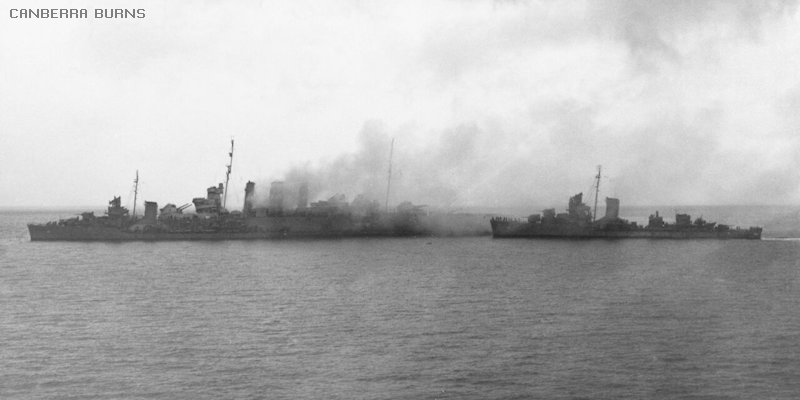
The QUINCY went down shortly after Mikawa left, followed soon after by the VINCENNES. The CANBERRA struggled on until morning, when it was finally sunk by the surviving ships in the force. After an agonized struggle to save the ASTORIA, it sank shortly after noon, following the explosion of a magazine. The CHICAGO and the PATTERSON were badly damaged. The four sunken vessels would be joined by others in the coming months, until the sea to the north of Guadalcanal became known as "Iron Bottom Sound".
* None of the Americans involved in the clash failed to realize that the US Navy had been handed a savage beating; among them, the "Battle of Savo Island" became more appropriately labeled the "Battle of the Sitting Ducks". The sole consolation was that the next day, Monday 10 August, the US Navy submarine S-44 spotted four IJN cruisers that had participated in the fight and put three torpedoes into the heavy cruiser KAKO, sending it to the bottom, most of the crew being rescued. Nothing was said publicly, for the time being, about the one-sided hammering the Allies had suffered off of Guadalcanal.
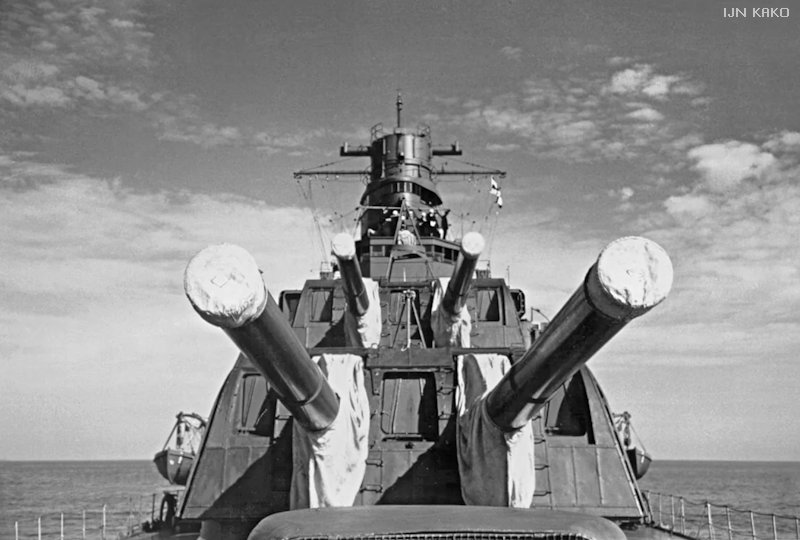
1,270 Allied sailors had been killed and 700 injured, left floundering in the sea. Admiral Turner chalked up the defeat to a baffling US Navy version of the victory disease, based on contempt for the "Japs" -- judged backwards and incompetent despite very strong evidence to the contrary, leading to a lack of readiness. US Navy officers also hadn't realized that their prewar training doctrine, on which they placed an excess of faith, was largely unrealistic, the neat setpiece exercises they had performed having very little relationship to the ugly, chaotic, savage brutality of a real battle.
In December, the Navy would conduct an inquiry into the disaster, under the direction of Admiral Arthur Hepburn. Many deficiencies were uncovered by the analysis, though the conclusion, endorsed even by the severe Admiral King, was that the blame was so thoroughly spread around as to make disciplinary actions pointless. The report was notably critical of Captain Bode, who committed suicide in response. The US Navy had a war to fight, and the conclusion was to become more "battle minded", to take heed of the lessons learned -- one being that Allied warships were still carrying around peacetime frills and unnecessary layers of paint that made them firetraps in a battle. The word went down to discard the frills and strip interior spaces down to bare steel, much to the misery of sailors all across the US Navy chipping away at the paint for the following months.
Communications protocols and fire-fighting techniques were also improved; stateside civilian fire department men taught the Navy about the "fog nozzle", in which a firehose produced a wide spray of water instead of a stream, which proved much more effective for fighting shipboard fires. Allied captains and admirals began to think harder of how things might be done better in the future. Their learning curve would prove difficult and painful, but the IJN would never get quite that lucky again in a surface fight against the Allies.
On the morning of 9 August 1942, the only relief the Americans could feel was over the failure of Mikawa to wipe out the American transports. Otherwise, the first naval battle of Guadalcanal, the Battle of Savo Island, was one of the most humiliating defeats ever suffered by the US Navy. The survival of the transports was of little immediate consolation to Vandegrift, since they had departed with a good portion of the supplies that couldn't be unloaded due to the logjam on the beach -- along with 1,400 Marines as well, sent to Espiritu Santo until they could rejoin their comrades. Once the transports disappeared over the horizon, the defenders of Guadalcanal were completely on their own. It was a hell of a way to run a war.
BACK_TO_TOP